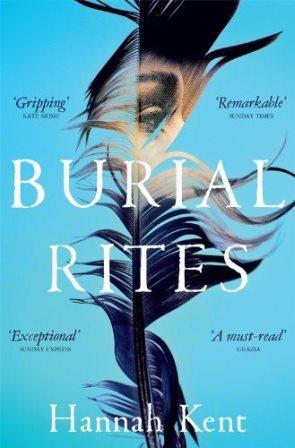
Being sentenced to die is tough. Waiting for the sentence to be carried out is even tougher.
Hannah Kent’s intriguing debut novel ‘Burial Rites’ focuses on one woman’s experience of this difficult time.
What’s it about?
Our perceptions of people and the power of story-telling. Agnes Magnúsdóttir has been condemned to die for her part in the murder of her lover. An absence of jails in Iceland means that she must stay with the family of a local, low-ranking official while she waits for her execution date to be set. The family don’t want a murderess in their home, but as the seasons change they gradually learn about Agnes’ life and their attitudes thaw just as winter arrives – and the execution date is set. Meanwhile, a young and inexperienced reverend is appointed as Agnes’ confessor to help her prepare for death. As she reveals her story, he begins to question her conviction, but the prosecutor will not be moved.
What’s it like?
‘They said I must die. They said I stole the breath from men, and now they must steal mine.’
Slow paced, well-written and atmospheric. This didn’t grip me straight away; I read the first chapter, wasn’t particularly interested, read a few other books, then started again from the beginning when I realised my book group deadline was approaching. Despite a powerful prologue (‘They said I must die. They said I stole the breath from men, and now they must steal mine.’) the opening pages don’t necessarily grab readers’ attention. There’s a note on Icelandic names, another on Icelandic punctuation. There’s documentation related to the case. Yes, this is historical fiction declaring itself loud and clear. *falls asleep*
Once you move past this, the story gains in interest as you see how the family react to the prisoner and begin to uncover her character. Kent uses first and third person narration throughout, typically using the first-person accounts to inform the reader of the elements of Agnes’ past that she does not wish to share in such explicit detail with her fascinated audience. And they are fascinated, knitting away in another corner of the badstofa, the communal room in which the whole family live, eat and sleep, while Agnes is gently prompted by the reverend to reveal her history.
We can choose whether or not to accept Agnes’ version of the murder scene, decide whether we think she is simply a manipulative story-teller or something more tragic.
Is Agnes a victim or a villain? Cleverly, Kent leaves this ambiguous to the end. We can choose whether or not to accept Agnes’ version of the murder scene, decide whether we think she is simply a manipulative story-teller or something more tragic. I really liked this aspect of the book, and the idea (promoted by Agnes’ chief prosecutor) that simply listening to her story could be dangerous. Kent reminds the reader of the sheer power of good storytelling through her characters and her own narrative. Really, it is the story itself that compels the reader to keep going, rather than any dramatic plot incidents or revelations.
Perhaps unsurprisingly, the novel is a little ‘heavy’ in its use of imagery. Similes and metaphors abound, and although they are often highly evocative, they are not subtle and could irritate some readers by their sheer obviousness and frequency. However, once you have adapted to Kent’s style they do become less noticeable and help create a convincing sense of place.
Final thoughts
Kent admits that she gave herself a huge challenge by deciding to write about an event which happened in a different country and a different century to her own, but she has done a lot of research and it’s a risk that’s worked. Life in 1920s Iceland is effectively portrayed through the day-to-day experience of Agnes and the Jonsson family. As the seasons change, they make hay, birth lambs and make blood sausages. There are some mildly gory scenes involving animals, which are actually more disturbing than the murder scene itself. Unlike some historical fiction, in which this might all feel very deliberate and constructed, these scenes emerge naturally from the family’s activities and all involve some progression of the story.
This debut novel is well-worth a read if you enjoy literary fiction with a historical bent. It has been marketed as a crime novel, too, but I’d argue that there isn’t sufficient focus on the crime or detection involved to warrant the books’s inclusion in that genre. Instead, the focus is on Agnes herself: who is she? What did she do? Why? The answer to the last question is crucial to understanding who Agnes really is.